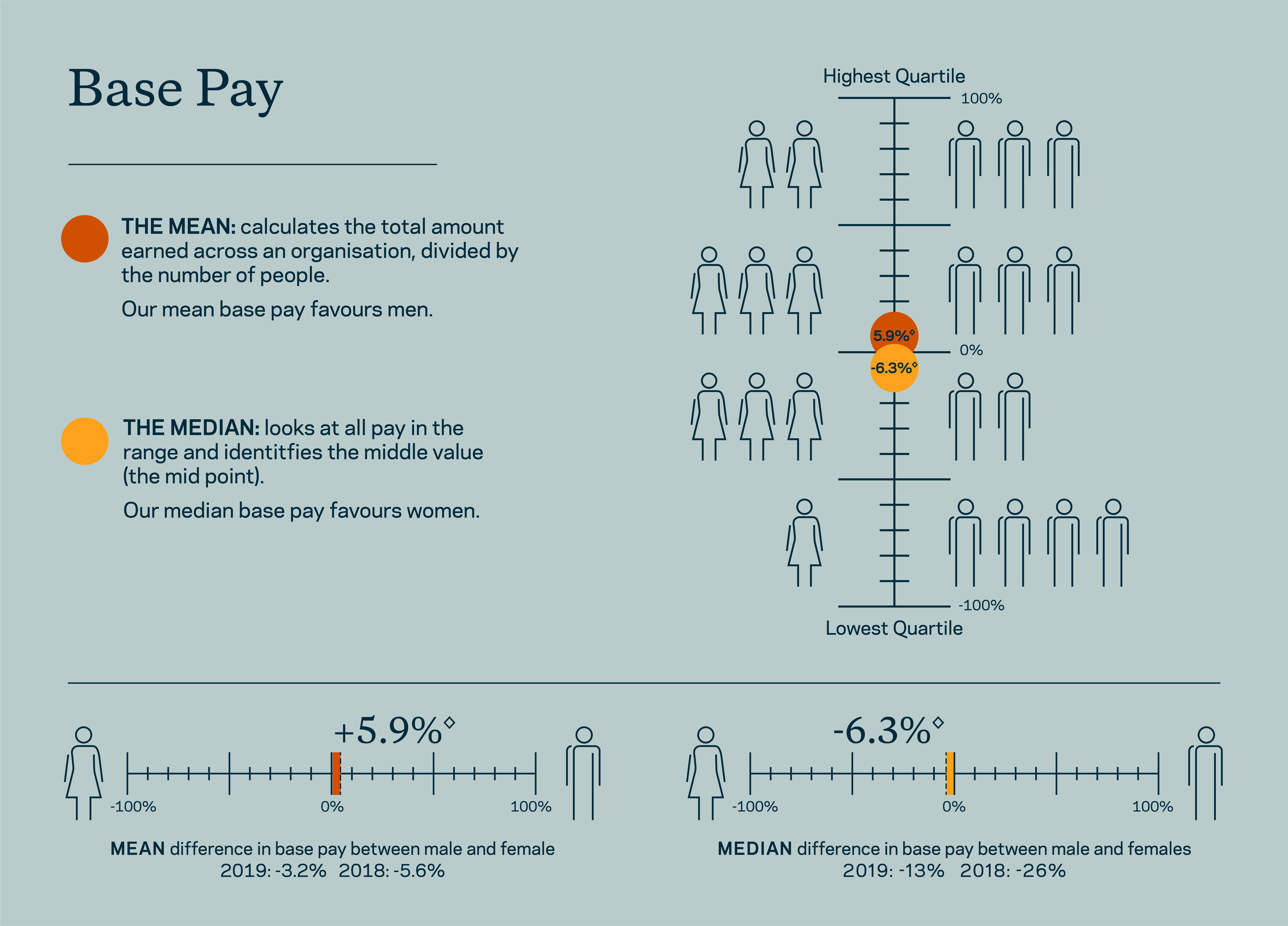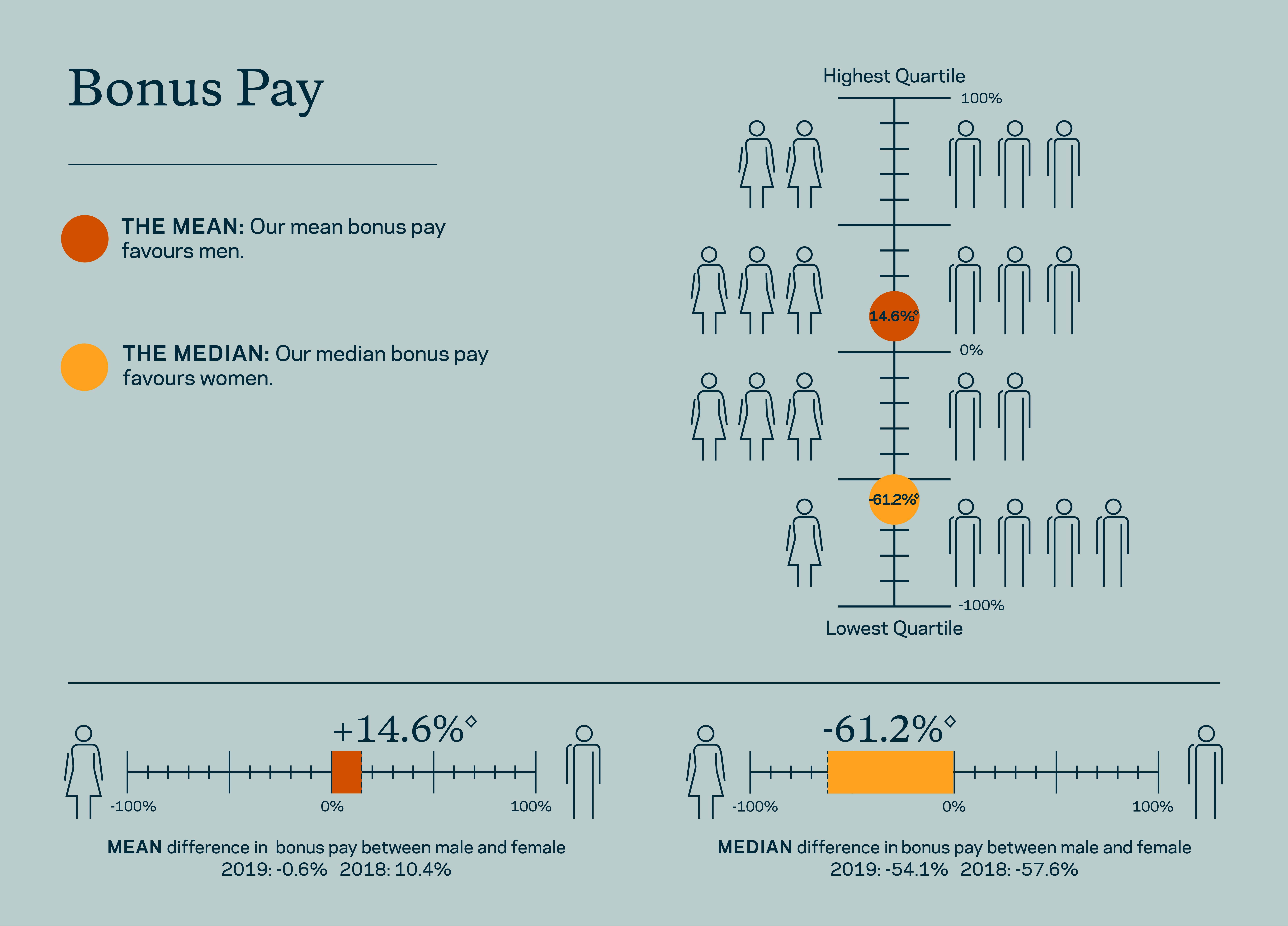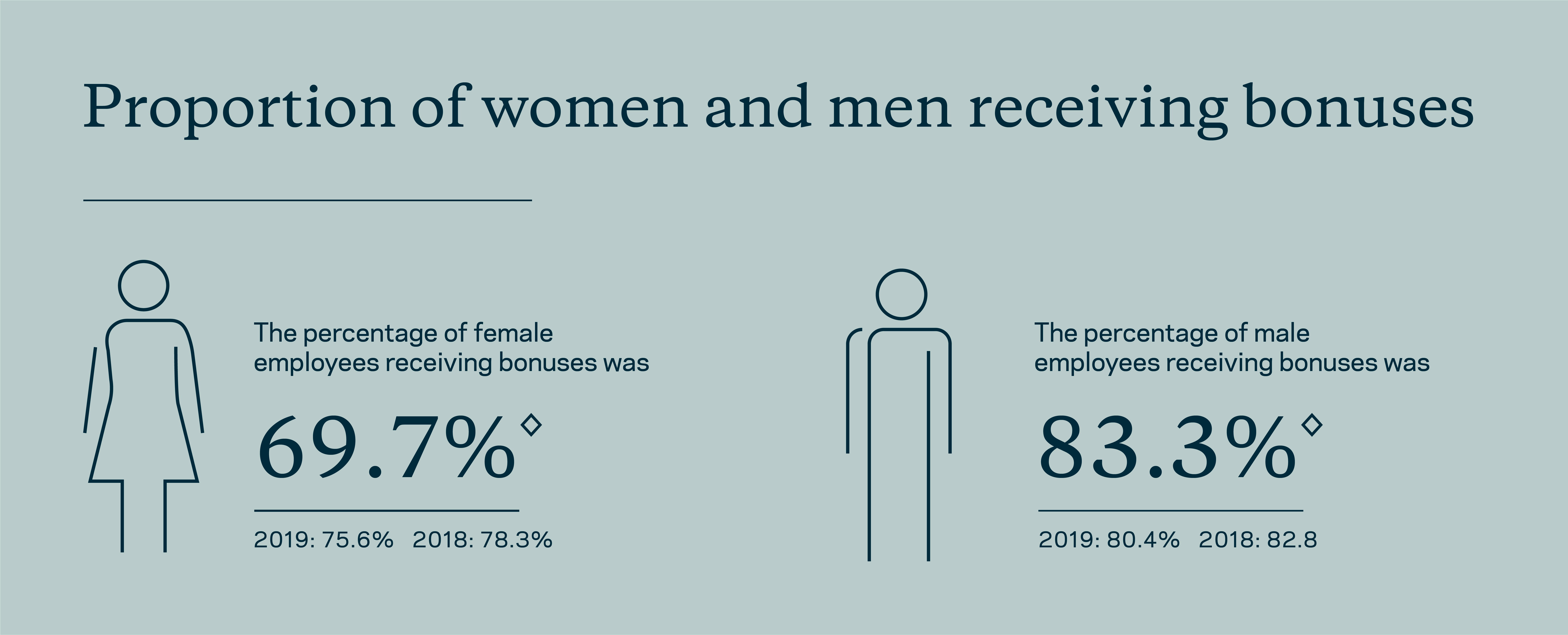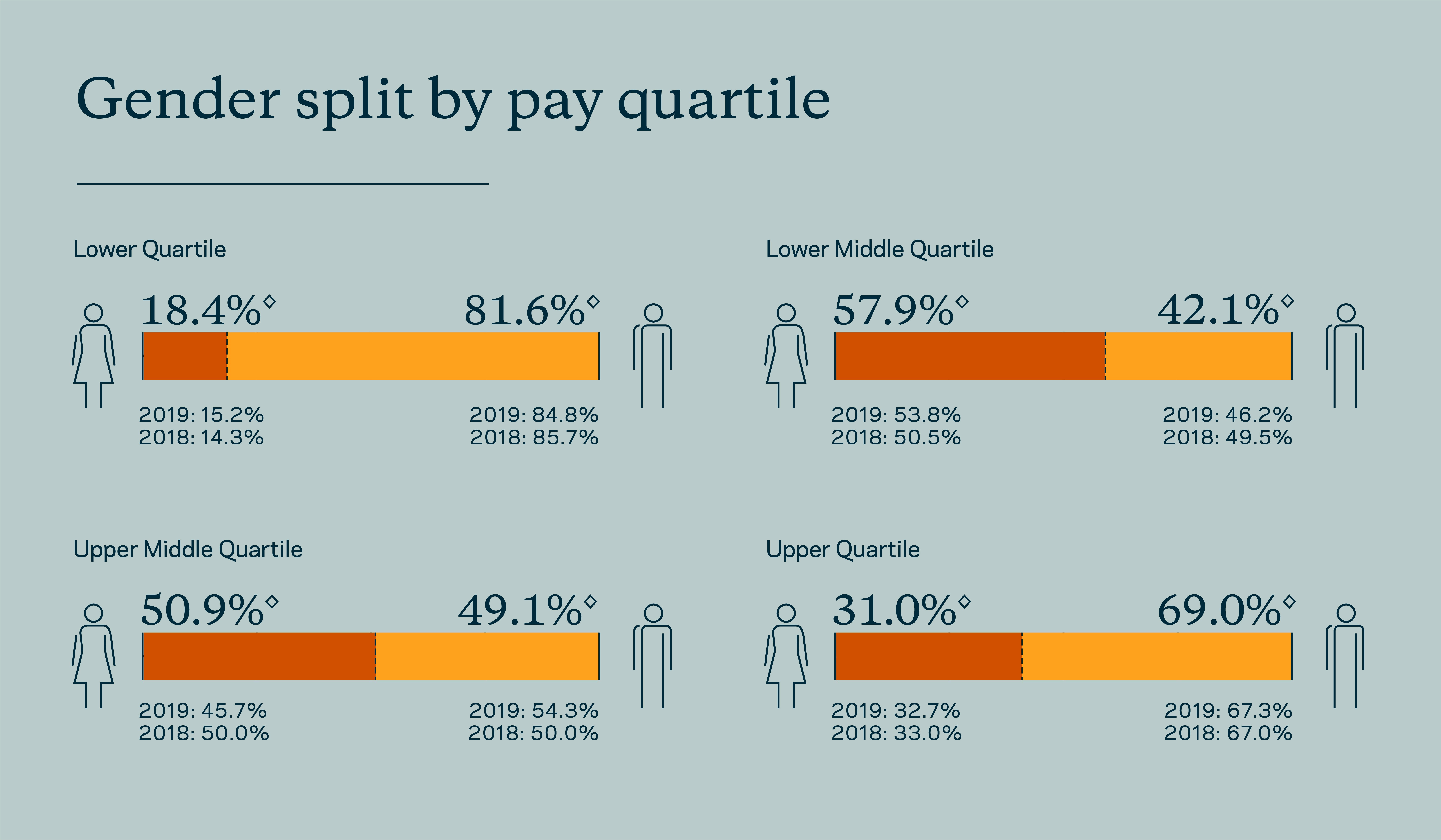
Gender pay: 2020
What is the Gender Pay Gap?
The gender pay gap looks at the difference in the average pay between all men and women in an organisation, taking account of the full range of jobs and salaries.
It is different from ‘equal pay’, which, as set out in the 2010 Equality Act, guarantees equal reward for men and women for doing the same or similar jobs, of equal value.
For context, the UK’s average gender pay gap is currently estimated to be around 15.5%, meaning that on average, men across the country typically out-earn their female colleagues by almost one fifth.
Gender Pay at The Crown Estate (figures from April 2020)
We know that ensuring everyone, regardless of their gender, ethnicity, sexuality, age and social background, has access to equal opportunities, including on recruitment, pay, and career progression is fundamental. This not only about creating a more just world, but also a more successful, sustainable business. It’s how we attract the best talent, motivate our people, support a healthier, more productive workplace, and better reflect the communities we serve.
As these figures show, there is still more to do in narrowing the gap across all parts of our business, and most notably better gender diversity across all levels of the organisation, particularly at a senior management level. We are focused on the actions we can take to make a real and lasting difference and ensure we achieve a meaningful, long-term trend towards balance.
Base pay
Since we began publishing our gender pay data (in 2017), our mean base pay gap has shifted from favouring women to favouring men, and the difference has widened. It now stands at 5.9%◊ (up from -3.2% in 2019). As a business with a relatively modest headcount (c.480 people, at time of reporting) relative to the size of our portfolio, even small changes in the makeup of our team can have a statistically significant impact on the figures we report.
In this case, the shift reflects a number of senior changes and in particular the appointment of a male Chief Executive since the last reporting period. Our median gap has reduced and now stands at -6.3%◊ (down from -13.0% last year).

Bonus Pay
Our bonus gap shows a similar shift, with our mean now standing at 14.6%◊ (up from -0.6% in 2019) and our median bonus pay gap at -61.2%◊ (up from -54.1% in 2019). The gap between the proportion of men and women receiving bonuses has also widened this year.
Our bonus reporting year is from April 2019 to March 2020 inclusive, and only those who joined prior to the 31 December 2018 were eligible to receive a bonus in the reporting period. As such, anyone joining after the 31 December 2018 was not eligible for a bonus payment, but would have been included in the pay gap data at the snapshot date. Of the employees who met the eligibility criteria and were employed prior to the 31 December 2018, virtually all received a bonus award in the reporting period. The bonus pay gap shown below primarily reflects the fact that a number of senior men became eligible for bonuses for the first time during this year’s reporting period, and by contrast, a number of female joiners in the population at the snapshot date, including several at the senior end of our pay scale, were temporarily ineligible for a bonus, as a result of more recent start dates.


Gender split by pay quartile
As the graphic below illustrates, while we have relatively balanced representation of men and women in the middle quartiles of our organisation, the higher and lower levels of our pay spectrum are disproportionately male.
This year, slight decreases in the number of male employees in the lower quartile and the upper middle quartile have helped bring these sections of our business closer to being in balance on pay. However, we have seen a small increase in the number of male employees in the upper pay band.

This distribution reflects a continuing split, evident across the wider economy, in the types of roles that men and women often occupy. For example, while we have a higher proportion of women in our People and Communications teams, the majority of our Estate team at Windsor are men, as are a majority of the most senior people in our London portfolio teams. What are we doing to close the gap?
Our aim is to build a truly diverse team, enabling our people to thrive in a collaborative and inclusive culture. Whilst we know we still have a way to go, we have taken a number of important steps to build the foundations for change.
This year, as part of our wider work to review our purpose and strategy, we have been reshaping how we organise ourselves as a business, to bring in new skills and ensure we are well positioned for the future. As part of this process, we are actively looking how we improve diversity balance across all levels of the organisation, and will be able to announce more details on this in the coming year.
We’ve also continued to develop and champion our Diversity + Inclusion working group, now co-chaired by our Chief Executive and Chief Operating Officer, to help drive us forward. This group spans five areas: gender, race, ethnicity and culture, accessibility, LGBT+, and eliminating systems bias.
In addition to this programmes, we have a number of processes in place to help support equality of opportunity and pay, and support a more balanced, and diverse workplace. These include:
A structured recruitment process, helping to support unbiased hiring decisions and ensure a mix of male, female and non-binary candidates. We have also introduced software to identify and eliminate gender bias in all recruitment communications, including job descriptions and adverts, and we source CVs without personal information such as names and gender.
Active monitoring of our talent pipeline by gender, ensuring that all employees have equal access to development and equal opportunity for progression and that this data is regularly shared with The Crown Estate’s senior leadership to support future strategy and hiring decisions.
Independent salary benchmarking against the market, irrespective of gender, across all of the sectors in which we operate.
A range of family friendly policies, including maternity, paternity, adoption, emergency care, and dynamic working, helping to ensure that caring responsibilities, often disproportionately taken on by women, aren’t a barrier to professional success.
For new parents, we offer shared parental leave and return to work coaching, giving both male and female colleagues access to up to 26 weeks leave on full pay, at any time within the first year of parenthood, as well as support for those who are transitioning back into the workplace, after time out. Since introducing this in Jan 2019, over 90% of women returning to work have taken this up.
Over the past year, recognising the additional pressures created by the pandemic, we’ve also lifted our cap on dependency leave, to ensure our team have the space to prioritise the family life and take the time off that’s needed to achieve this balance.
Though we’re seeing some progress in these areas, we will continue to challenge ourselves to tackle some of the systemic challenges that underpin imbalance; including attracting a broader mix of people and backgrounds into our sectors at all levels, as we strive to build an ever stronger organisation.
Judith Everett Chief Operating Officer
For more information on how we calculate our Gender Pay Gap, please see our methodology.
Limited Assurance: KPMG LLP has provided independent limited assurance over selected gender pay gap data highlighted on this webpage with the symbol ◊, using the assurance standard ISAE (UK) 3000. KPMG has issued an unqualified opinion over the selected data. KPMG’s full assurance statement is available below, which together with our Reporting Criteria, should be read in conjunction with the assured gender pay gap data above.
Document downloads
KPMG Limited Assurance Report 2020
Download (186KB)